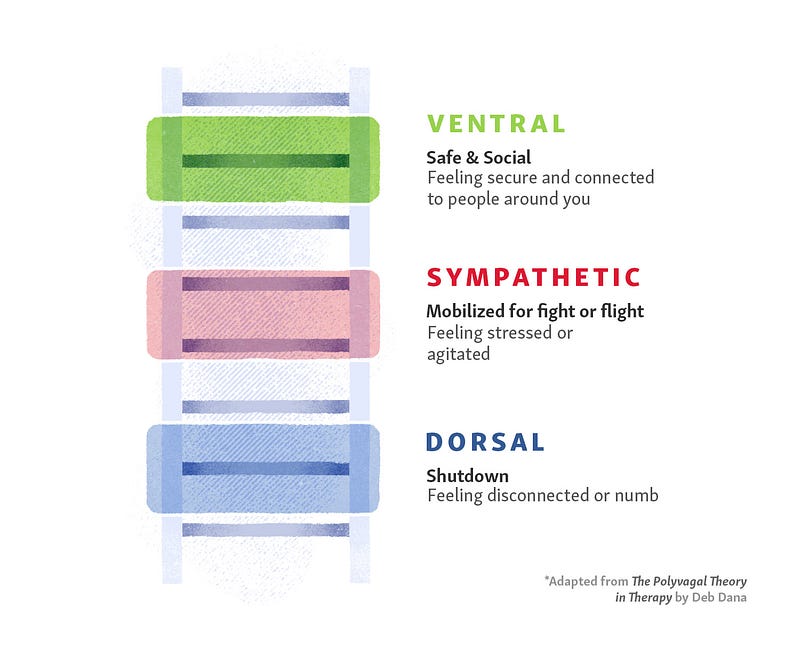Exploring Somatic Therapy: A Pathway to Healing Trauma
Written on
Understanding Trauma Responses
Have you ever found yourself feeling trapped even after undergoing traditional talk therapy for months or even years?

Photo by Joel Overbeck on Unsplash
Recently, I had a conversation with my therapist about a recurring dilemma. I would be triggered by a certain event, and though I could eventually guide my thoughts back to a safe mental space, my body seemed to have a different reaction entirely. Despite my brain's attempts to rationalize and anchor me in the present, my body would respond by slipping into trauma-induced reactions. I could feel myself shutting down as my mind fought hard to maintain stability. Unfortunately, my body would pull me deeper into the shadows of Complex PTSD (C-PTSD).
Even as my mind sent soothing signals, my body and nervous system struggled to respond positively. I would experience heat at the back of my neck, a crushing sensation in my stomach, and an overwhelming heaviness that left me feeling encased in fear.
Upon sharing this with my therapist, she introduced me to the concept of somatic therapy, suggesting that I explore this approach. She highlighted how trauma often resides within the body, and, unfortunately, our bodies retain memories of these experiences.
What is Somatic Therapy?
While many therapeutic methods utilize a top-down strategy, such as talk therapy which focuses on cognitive processes, Somatic Experiencing (SE) employs a bottom-up method. This approach prioritizes bodily experiences to help reframe trauma responses that affect the nervous system.
“When a person is exposed to overwhelming stress, threat or injury, they develop a procedural memory. Trauma occurs when these implicit procedures are not neutralized. The failure to restore homeostasis is at the basis for the maladaptive and debilitating symptoms of trauma.” — Peter A Levine, PhD
Our bodies are naturally designed to safeguard us against threats. For those who have endured trauma, these protective responses can become ingrained. For instance, if a raised voice once resulted in physical harm, the body may react by cowering at any similar sound. Similarly, if criticism led to emotional pain, the body may instinctively shut down in response to any form of critique, whether constructive or not.
The Adaptive Nature of the Nervous System
The nervous system is remarkably adaptive, crafted to shield us from harm. However, when we are no longer faced with genuine threats, these protective mechanisms can transform into debilitating responses.
Somatic therapy provides a secure environment to confront and comprehend these trauma responses. Therapists guide individuals in practicing mindfulness, helping them to safely navigate moments of distress and gain insights into their bodily reactions. A significant focus is placed on recognizing and processing various trauma responses, such as flight, fight, freeze, and fawn.
How Trauma Responses Manifest

Credit: Deb Dana
Trauma is intricately tied to the body, which can involuntarily revert to trauma responses when faced with perceived threats. The Polyvagal Theory examines the intricacies of these responses. When we feel secure, our brain and body function within the ventral vagal state of the parasympathetic nervous system. In this state, we can relax, our immune system functions properly, and digestion is efficient.
As we move down the ladder, we enter the sympathetic nervous system where the fight or flight responses come into play. Here, heart rates elevate, adrenaline surges, and our ability to connect with others diminishes, alongside other vital bodily functions.
The final rung is the dorsal vagal state, often associated with a freeze response during extreme situations. In this state, the body releases endorphins to numb pain, leading to decreased heart rate and temperature, along with a diminished awareness of surroundings. Feelings of hopelessness can dominate as the body seeks to conserve energy.
Many individuals who turn to SE find themselves trapped in these trauma responses, even in safe environments. Triggers can prompt automatic reactions, overshadowing cognitive awareness of safety. SE aims to help individuals recalibrate their bodily responses to safely navigate their nervous system.
Dr. Levine posits that it isn’t the traumatic event itself that leads to enduring trauma but rather the overwhelming response to perceived threats that disrupts the nervous system's balance. The aim of SE is to diminish the hold of the trauma narrative and remap bodily memories to restore a sense of vitality and flow.
Exploring Somatic Experiencing
Somatic therapy may not suit everyone, but if you find yourself feeling mentally clear yet physically stuck, it might be worth considering. My own journey into SE was driven by frustration; I felt trapped in a freeze response, and my brain seemed disconnected from my body. While my mind could effectively utilize tools learned in talk therapy, my body's reactions often derailed my progress.
SE offers a valuable introduction to body-centered therapies. Similar to dance therapy and yoga, which foster a connection between mind and body, SE emphasizes the importance of the nervous system in the healing process—an aspect often overlooked in traditional talk therapy. As humans, our animalistic nature means our nervous system significantly influences our reactions. SE and other body-based therapies facilitate a deeper understanding and acceptance of our bodily responses to trauma and stress.
It's crucial to recognize that symptoms stemming from a dysregulated nervous system are not a permanent condition. Individuals grappling with PTSD or mental health challenges must discover their own unique blend of healing methods. While some may find relief through talk therapy, others may benefit from art therapy, yoga, or body-oriented therapies. Each person's journey is distinct, and it's essential to explore the available tools. Healing is rarely a straightforward path, and there is no universally correct approach.
Healing the Nervous System from Trauma: Somatic Experiencing
This video delves into the principles of somatic experiencing, highlighting its effectiveness in addressing trauma responses stored in the body.
Somatic Practice for Trauma and Stress Release
In this video, practitioners demonstrate somatic exercises aimed at releasing trauma and stress, promoting greater bodily awareness and healing.
Thank you for reading! If you appreciate my writing, please consider joining my free email list and following me on Twitter.